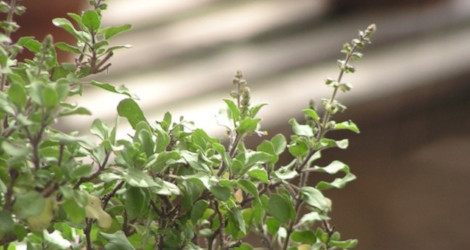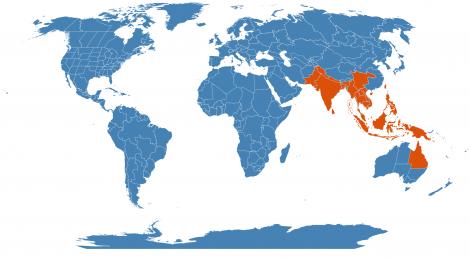Accession Data:
Ocimum tenuiflorum L.
- Common Name: Holy Basil
- Family: Lamiaceae Lindl.
- Synonym(s): Ocimum sanctum L.
- Uses: Tulasi is cultivated for religious and medicinal purposes, and for its essential oil. It is widely known across the Indian subcontinent as a medicinal plant and an herbal tea, commonly used in Ayurveda, and has an important role within the Vaishnava tradition of Hinduism, in which devotees perform worship involving holy basil plants or leaves. This plant is revered as an elixir of life.3
Modern Studies have shown Holy Basil to protect the body from chemical stresses, pollution, toxicity and heavy metals.
It has shown to have antimicrobial and antibacterial properties. Used to sanitize cuts and wounds, ulcers, and mouth sores.
This plant is traditionally used to regulate blood sugar and blood pressure. Used as a purifier and tonic.
Tulasi is an anxiolytic and anti-depressant, aides in balancing hormones and development of the brain. This plant has been found to help with memory, cognitive learning, anxiety and depression.
This plant traditionally is considered to have holistic medicinal properties, covering a large variety of ailments in all respects: eye disorders, back pain, skin disease, ring worm, snake bites, muscle stiffness, etc.
Normalizes Kapha and Vata
- IMPORTANT NOTE: Plant Uses are for informational purposes only. EEB Greenhouses assume no responsibility for adverse effects from the use of any plants referred to on this site. Always seek advice from a professional before using any plant medicinally.
- USDA Zone: 10b-11
Accession Data:
- Accession # 201500040
- Source: Rob Nicholson - Smith College
- Accession Date: 05-29-2015
- Bench: 1201 - AUS:West Bench NN
- Currently: active - healthy
- Qty: 1 confirmed on 02-26-2025
Classification:
- Division: Magnoliophyta
- Class: Magnoliopsida
- SubClass: euasterid I
- Order: Lamiales
- SubOrder:
- Family: Lamiaceae
- SubFamily: Nepetoideae
- Tribe: Ocimeae
- SubTribe: Ociminae
Flowering Data:
This accession has been observed in bloom on:| Year | Jan | Feb | Mar | Apr | May | Jun | Jul | Aug | Sep | Oct | Nov | Dec | ||||||||||||||||||||||||||||||||||||||||
|---|---|---|---|---|---|---|---|---|---|---|---|---|---|---|---|---|---|---|---|---|---|---|---|---|---|---|---|---|---|---|---|---|---|---|---|---|---|---|---|---|---|---|---|---|---|---|---|---|---|---|---|---|
| 2025 | ||||||||||||||||||||||||||||||||||||||||||||||||||||
| 2024 | ||||||||||||||||||||||||||||||||||||||||||||||||||||
| 2023 | ||||||||||||||||||||||||||||||||||||||||||||||||||||
| 2022 | ||||||||||||||||||||||||||||||||||||||||||||||||||||
| 2021 | ||||||||||||||||||||||||||||||||||||||||||||||||||||
| 2020 | ||||||||||||||||||||||||||||||||||||||||||||||||||||
| 2019 | ||||||||||||||||||||||||||||||||||||||||||||||||||||
| 2018 | ||||||||||||||||||||||||||||||||||||||||||||||||||||
| 2017 | ||||||||||||||||||||||||||||||||||||||||||||||||||||
| 2016 | ||||||||||||||||||||||||||||||||||||||||||||||||||||
| 2015 | ||||||||||||||||||||||||||||||||||||||||||||||||||||
References (internal):
- Medicinal Plants
- Medicinal Plants - Ayurveda Medicine
- Medicinal Plants - Nervous System
- Medicinal Plants - Digestive System
- Medicinal Plants - Circulatory System
- Medicinal Plants - Immune System
- Currently Featured Medicinal Plants
- EEB Greenhouse Holdings native to: China South-Central / Hainan / Taiwan / Assam / Bangladesh / India / Nepal / Pakistan / Sri Lanka / West Himalaya / Andaman Is. / Cambodia / Laos / Myanmar / Nicobar Is. / Thailand / Vietnam / Borneo / Jawa / Lesser Sunda Is. / Malaya / Maluku / Philippines / Sulawesi / Sumatera / New Guinea / Queensland /
References (external):
- The Plant List (2013). Version 1.1. Accessed 29 May 2015.
- WCSP (2015). World Checklist of Selected Plant Families. Facilitated by the Royal Botanic Gardens, Kew. Accessed 29 May 2015.
- Ocimum tenuiflorum at Wikipedia. Accessed 29 May 2015.
- Marc Maurice Cohen Tulsi - Ocimum sanctum: A herb for all reasons J Ayurveda Integr Med. 2014 Oct-Dec; 5(4): 251–259. Last accessed on Thursday, February 15, 2018.
- Image #00 (cropped) & #01 (original) by en:User:GourangaUK [Public domain], via Wikimedia Commons. Last accessed Wednesday, 14 November, 2018.
data regenerated on Sat, 24 May 2025 13:27:29 -0400 [bcm v4.0]
Images:

Additional images for this accession:
Click on thumbnails to enlargeCurrent Accessions in the Lamiaceae
Subfamily Ajugoideae
- Clerodendrum nutans


- Clerodendrum speciosissimum


- Clerodendrum thomsoniae


- Faradaya splendida

- Petraeovitex bambusetorum


- Teucrium chamaedrys

- Teucrium fruticans

Subfamily Lamioideae
Tribe Pogostemoneae
Subfamily Lamioideae
Tribe Stachydeae
Subfamily Nepetoideae
Tribe Mentheae
- Lycopinae: Lycopus europaeus

- Menthinae: Thymus kotschyanus

- Prunellinae: Prunella grandiflora

- Salviinae: Rosmarinus officinalis


- Salviinae: Salvia discolor

- Salviinae: Salvia microphylla


- Salviinae: Salvia officinalis


- Salviinae: Salvia pinguifolia


Subfamily Nepetoideae
Tribe Ocimeae
- Lavandulinae: Lavandula angustifolia


- Lavandulinae: Lavandula dentata

- Ociminae: Ocimum tenuiflorum


- Plectranthinae: Coleus scutellarioides

- Plectranthinae: Coleus scutellarioides

- Plectranthinae: Plectranthus amboinicus

- Plectranthinae: Plectranthus neochilus


- Plectranthinae: Plectranthus saccatus


- Plectranthinae: Tetradenia riparia

Subfamily Prostantheroideae
Tribe Westringieae
Subfamily Scutellarioideae
- Holmskioldia sanguinea


- Scutellaria alpina


- Scutellaria argentata


- Scutellaria javanica


- Scutellaria purpurascens subsp. verecunda W/C

- Scutellaria tuberosa W/C

Subfamily Symphorematoideae
Subfamily Viticoideae
W/C = Wild Collected = indicates flowering in past 14 days
= indicates flowering in past 14 days
 = images available for this accession
= images available for this accession
 = map available for this accession
= map available for this accession
 = accession added within past 90 days
= accession added within past 90 days

